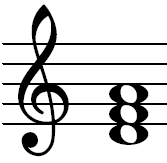User:Stephen Burnett/Music
Quality and triads
[edit]The quality of a triad is determined by the precise arrangement of its intervals. Tertian trichords, known as triads, can be described as a series of three notes. The first element is called the root note of the chord, the second note is called the "third" of the chord, and the last note is called the "fifth" of the chord. These are described below:
| Chord name | Component intervals | Example | Chord symbol | |
|---|---|---|---|---|
| major triad | major third | perfect fifth | C-E-G | C, CM, Cma, Cmaj |
| minor triad | minor third | perfect fifth | C-E♭-G | Cm, Cmi, Cmin |
| augmented triad | major third | augmented fifth | C-E-G# | C+, C+, Caug |
| diminished triad | minor third | diminished fifth | C-E♭-G♭ | Cm(♭5), Cº, Cdim |
As an example, consider an octave of the C major scale, consisting of the notes C D E F G A B C.
 |

The major triad formed using the C note as the root would consist of C (the root note of the scale), E (the third note of the scale) and G (the fifth note of the scale). This triad is major because the interval from C to E is a major third.

Using the same scale (and thus, implicitly, the key of C major) a minor chord may be constructed using the D as the root note. This would be D (root), F (third note), A (fifth note).
Examination at the piano keyboard will reveal that there are four semitones between the root and third of the chord on C, but only 3 semitones between the root and third of the chord on D (while the outer notes are still a perfect fifth apart). Thus the C triad is major while the D triad is minor.
A triad can be constructed on any note of the C major scale. These will all be either minor or major, with the exception of the triad on B, the leading-tone (the last note of the scale before returning to a C, in this case), which is diminished. For more detail see the article on the Mathematics of the Western music scale.
